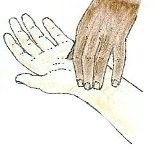Resource 3: Heart rate
![]() Background information / subject knowledge for teacher
Background information / subject knowledge for teacher
Heart rate is a term used to describe the frequency of the cardiac cycle. It is considered one of the four vital signs. Usually it is calculated as the number of contractions (heart beats) of the heart in one minute and expressed as ‘beats per minute’ (bpm).
When resting, the adult human heart beats at about 70 bpm (males) and 75 bpm (females), but this rate varies among people. However, the reference range is nominally between 60 bpm (if less, termed bradycardia) and 100 bpm (if greater, termed tachycardia). Resting heart rates can be significantly lower in athletes. The infant/neonatal rate of heartbeat is around 130–150 bpm, the toddler's about 100–130 bpm, the older child's about 90–110 bpm, and the adolescent's about 80–100 bpm.
The body can increase the heart rate in response to a wide variety of conditions in order to increase the cardiac output (the amount of blood ejected by the heart per unit time). Exercise, environmental stressors or psychological stress can cause the heart rate to increase above the resting rate.
Measuring heart rate

Measuring the pulse at the neck and wrist
The pulse rate (which in most people is identical to the heart rate) can be measured at any point on the body where an artery is close to the surface. Such places are wrist (radial artery), neck (carotid artery), elbow (brachial artery), and groin (femoral artery). The pulse can also be felt directly over the heart. (Remember, never use your thumb to measure your pulse rate.)
It is also possible to measure heart rate acoustically, by listening to the sounds the heart makes while beating. These sounds can be listened to using a stethoscope.
Maximum Heart Rate (MHF):
A quick way to estimate MHR is to subtract your age from 220.
Training Zones:
Healthy Heart Zone (Warm up) — 50–60% of maximum heart rate: The easiest zone and probably the best zone for people just starting a fitness program. It can also be used as a warm up for more serious walkers. This zone has been shown to help decrease body fat, blood pressure and cholesterol. It also decreases the risk of degenerative diseases and has a low risk of injury. Fats are 85% of food energy burned in this zone.
Fitness Zone (Fat Burning) — 60–70% of maximum heart rate: This zone provides the same benefits as the healthy heart zone, but is more intense and burns more total food energy. The percent of food energy from fat is still 85%.
Aerobic Zone (Endurance Training) — 70–80% of maximum heart rate: The aerobic zone will improve your cardiovascular and respiratory system and increase the size and strength of your heart. This is the preferred zone if you are training for an endurance event. More food energy is burned with 50% from fat.
Anaerobic Zone (Performance Training) — 80–90% of maximum heart rate: Benefits of this zone include an improved maximum (the highest amount of oxygen one can consume during exercise) and thus an improved cardiorespiratory system, and a higher lactate tolerance ability which means your endurance will improve and you'll be able to fight fatigue better. This is a high intensity zone burning more food energy, 15% from fat.
Adapted from: Wikipedia, Website http://en.wikipedia.org [Tip: hold Ctrl and click a link to open it in a new tab. (Hide tip)] (Accessed 2008)
Resource 2: How mind maps can help mathematics teachers and pupils



